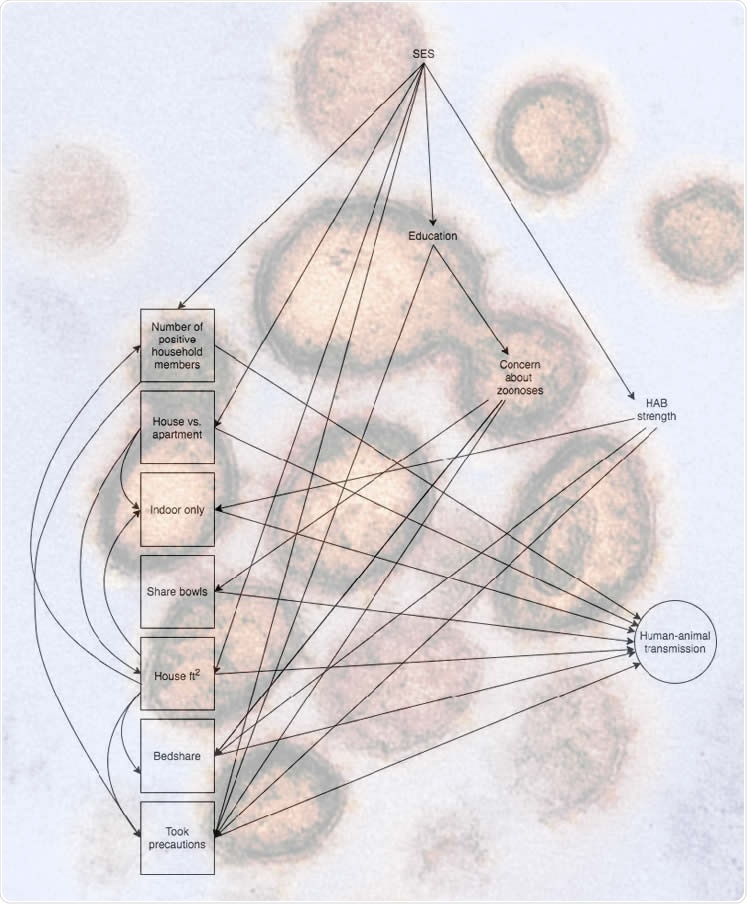Coronaviruses are seen in multiple mammalian species. Severe acute respiratory syndrome coronavirus 2 (SARS-CoV-2), the causative agent of the COVID-19 pandemic, is said to have passed to humans from a mammalian source and to have originated from an animal reservoir as a zoonotic pathogen.
Although the virus is spreading from person to person currently, the angiotensin-converting enzyme 2 (ACE2) receptor that facilitates the entry of SARS-CoV-2 is present in many species. There are several reports of domestic animals infected with SARS-CoV-2, including cats and dogs. So far, roughly 76 cats and 51 dogs have been reported to have confirmed SARS-CoV-2 infection by the USDA-APHIS based on antibody or PCR testing.
Workplace SARS-CoV-2 transmission from humans to animals has been documented in zoos and on mink farms. This is in line with previous reports of cats and ferrets infected with SARS-CoV-1 and lab studies showing experimental SARS-CoV-2 infection in non-human primates, hamsters, rabbits, and ferrets. However, not much is known about the frequency and risk factors for SARS-CoV-2 transmission from humans to animals in a household setting.
Community-based study of household pets to assess human to animal SARS-CoV-2 transmission
Researchers from the US recently carried out a community-based study of household pets with one or more confirmed SARS-CoV-2 cases in humans living in the household.
Data was collected with the help of a survey of human and animal demographics and clinical parameters, human-animal contact, aspects in their shared environment. Blood was collected from the animals to test for anti-SARS-CoV-2 antibodies, and nasopharyngeal swabs were collected for PCR testing for the virus. The study is published on the bioRxiv* preprint server.

23.7% of the dogs studied had clinical symptoms of COVID-19 and 43.1% had SARS-CoV-2 antibodies
The researchers have reported interim findings from their sampling of dogs. Samples were gathered from 67 dogs in 46 households. Results from nasopharyngeal testing were available for 58 dogs, and serological testing results for 51 dogs. Clinical symptoms of COVID-19 were reported in 14 dogs (23.7%), and SARS-CoV-2 antibodies were detected in 22 dogs (43.1%). The results of all PCR tests on nasopharyngeal swabs were negative.
Survey results showed that close human-animal contact was common, and most households were aware of and followed measures to minimize human-to-animal transmission of SARS-CoV-2 after diagnosis. Although there were no statistically significant associations between human-animal contact variables and COVID-19-like illness or seropositivity in dogs, there were positive trends for sharing beds with humans and the number of virus-positive humans in the corresponding household. Measures reportedly taken to mitigate transmission to pets showed a protective trend. A dog with a COVID-19-like illness was also found to be seropositive for the virus.
“These data indicate that human-to-animal transmission of SARS-CoV-2 in households is common, in a study population characterized by close human-animal contact.”
Findings show that human-to-animal SARS-CoV-2 transmission in households is quite common
The findings indicate that the transmission of SARS-CoV-2 from human-to-animal in households is common in a study population with close human-animal contact. They also show that infected pets often show signs of COVID-like disease. Although nasopharyngeal sampling of dogs did not show positive PCR results in this study, it could be because of delays in sampling.
Household members were taking precautions to protect companion animals from SARS-CoV-2 infection, which indicated an opportunity for implementing more measures to decrease transmission of SARS-CoV-2 between humans and animals sharing households.
According to the authors, the study offers important and novel insights into the cross-species transmission of SARS-CoV-2 in a household setting. Moreover, human, animal, and environmental data collected during the study represents an accurate One Health approach to this research.
The findings indicate the willingness of households in the study population to adopt strategies to protect their pets from SARS-CoV-2 infection. These measures can effectively prevent household transmission of zoonoses and anthropozoonoses.
“As vaccine roll-out continues and human-to-human transmission wanes, and in preparation for the next pandemic of zoonotic origin, rigorous characterization of the nature of human-animal contact within households, and the implications of this contact for disease transmission, is critical.”
*Important Notice
bioRxiv publishes preliminary scientific reports that are not peer-reviewed and, therefore, should not be regarded as conclusive, guide clinical practice/health-related behavior, or treated as established information.
- Household transmission of SARS-CoV-2 from humans to dogs in Washington and Idaho: burden and risk factors Julianne Meisner, Timothy V. Baszler, Kathryn H. Kuehl, Vickie Ramirez, Anna Baines, Lauren A. Frisbie, Eric T. Lofgren, David M. DeAvila, Rebecca M. Wolking, Dan S. Bradway, Peter M. Rabinowitz, bioRxiv, 2021.04.24.440952; doi: https://doi.org/10.1101/2021.04.24.440952,
- https://www.biorxiv.org/content/10.1101/2021.04.24.440952v1
https://news.google.com/__i/rss/rd/articles/CBMicmh0dHBzOi8vd3d3Lm5ld3MtbWVkaWNhbC5uZXQvbmV3cy8yMDIxMDQyOS9IdW1hbi10by1hbmltYWwtdHJhbnNtaXNzaW9uLW9mLVNBUlMtQ29WLTItaW4taG91c2Vob2xkcy1pcy1jb21tb24uYXNweNIBdmh0dHBzOi8vd3d3Lm5ld3MtbWVkaWNhbC5uZXQvYW1wL25ld3MvMjAyMTA0MjkvSHVtYW4tdG8tYW5pbWFsLXRyYW5zbWlzc2lvbi1vZi1TQVJTLUNvVi0yLWluLWhvdXNlaG9sZHMtaXMtY29tbW9uLmFzcHg?oc=5
2021-04-30 03:14:00Z
52781553995683
Bagikan Berita Ini














0 Response to "Human to animal transmission of SARS-CoV-2 in households is common - News-Medical.Net"
Post a Comment